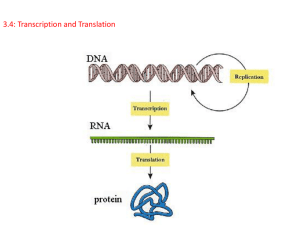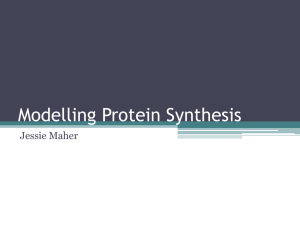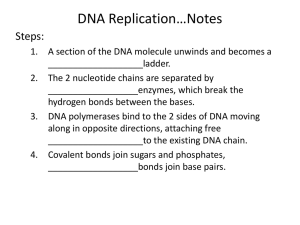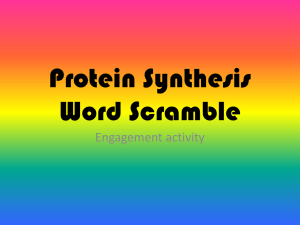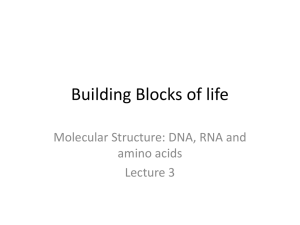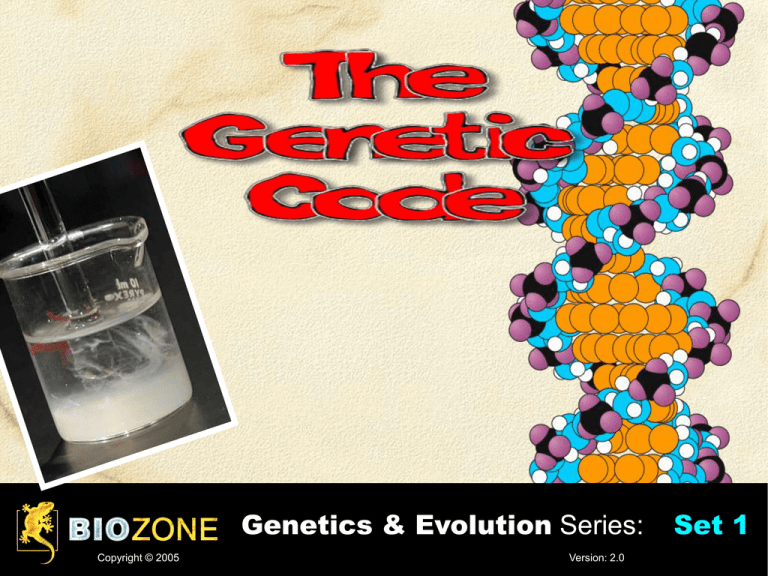
Genetics & Evolution Series:
Copyright © 2005
Version: 2.0
Set 1
DNA and protein synthesis
•
Learn these slides in conjunction with the Intranet pages that explain
what your need to learn and your textbook.
•
Your textbook lacks information on certain sections – use these PP
slides as your notes.
•
Work that you are not required to learn is marked for data response
only or for interest.
•
In some slides there may be more detail than you are required to
know – your teacher will help you determine the detail needed.
Genes in Eukaryote Cells
Eukaryotes have genetic
information stored in chromosomes
in the nucleus of each cell:
Cytoplasm: The nucleus
controls cell metabolism; the
many chemical reactions that
keep the cell alive and
performing its designated role.
Nucleus
Nucleus contains inherited
information: The total
collection of genes located on
chromosomes in the nucleus
has the complete instructions
for constructing a total
organism.
Structure of the nucleus
Nuclear membrane
encloses the nucleus
in eukaryotic cells
Chromosomes are made up of
DNA and protein and store the
information for controlling the cell
Nuclear pores are
involved in the active
transport of
substances into and
out of the nucleus
Nucleolus is involved
in the construction of
ribosomes
Genes Outside the Nucleus
in Eukaryote Cells
Mitochondrial
DNA
Eukaryotes have two types of
organelles with their own DNA:
Mitochondrion
mitochondria
chloroplasts
Ribosome
The DNA of these organelles is
replicated when the organelles
are reproduced (independently
of the DNA in the nucleus).
Chloroplast
Chloroplast DNA
Types of Nucleic Acid
Nucleic acids are found in two forms: DNA and RNA
DNA is found in the following places:
Chromosomes in the nucleus of eukaryotes
Chromosomes and plastids of prokaryotes
Mitochondria
Chloroplasts of plant cells
RNA is found in the following forms:
Transfer RNA:
tRNA
Messenger RNA: mRNA
Ribosomal RNA: rRNA
Genetic material of some viruses
Nucleotides
The building blocks of nucleic acids (DNA and RNA) comprise the
following components:
a sugar (ribose or deoxyribose)
a phosphate group
a base (four types for each of DNA and RNA)
Adenine
Phosphate
Sugar
Base
Structure of Nucleotides
The chemical structure of nucleotides:
Symbolic form
Phosphate: Links
neighboring sugars
Base: Four types are possible
in DNA: adenine, guanine,
cytosine and thymine. RNA
has the same except uracil
replaces thymine.
Sugar: One of two types
possible: ribose in RNA
and deoxyribose in DNA
Nucleotide Bases
Purines
The base component of
nucleotides which comprise
the genetic code.
Adenine
• Double-ringed
structures
• Always pair up
with pyrimidines
Guanine
Pyrimidines
Cytosine
Base component
of a nucleotide
• Single-ringed
structures
• Always pair up
with purines
Thymine
Uracil
DNA Structure
Phosphates link neighboring nucleotides together to
form one half of a double-stranded DNA molecule:
Purine base
(guanine)
Pyrimidine base
(cytosine)
Sugar
(deoxyribose)
Phosphate
Hydrogen
bonds
Pyrimidine base
(thymine)
Purine base
(adenine)
DNA Molecule
Purines join with pyrimidines
in the DNA molecule by way of
relatively weak hydrogen
bonds with the bases forming
cross-linkages.
Symbolic representation
This leads to the formation of a
double-stranded molecule of
two opposing chains of
nucleotides:
The symbolic diagram shows
DNA as a flat structure.
The space-filling model shows
how, in reality, the DNA molecule
twists into a spiral structure.
Hydrogen bonds
Space-filling model
DNA & RNA Compared
Structural differences between DNA and RNA include:
DNA
RNA
Strands
Double
Single
Sugar
Deoxyribose
Ribose
Bases
Guanine
Guanine
Cytosine
Cytosine
Thymine
Uracil
Adenine
Adenine
Nucleic Acids
What does DNA look like?
It’s not difficult to isolate DNA from cells.
The DNA extracted from a lot of cells
can be made to form a whitish, glue-like
material.
DNA
DNA Replication 1
Single-armed chromosome
as found in non-dividing cell
DNA is replicated to
produce an exact copy
of a chromosome in
preparation for cell
division.
The first step requires
that the coiled DNA is
allowed to uncoil by
creating a swivel point.
Temporary break
to allow swivel
Replication fork
DNA Replication 2
New pieces of DNA
are formed from free
nucleotide units joined
together by enzymes.
Free nucleotides
are used to construct
the new DNA strand
Parent strand of DNA is
used as a template to
match nucleotides for
the new strand
The free nucleotides
(yellow) are matched
up to complementary
nucleotides in the
original strand.
The new strand of
DNA is constructed
using the parent
strand as a template
DNA Replication 3
The two new strands of
DNA coil up into a helix.
Each of the two newly
formed DNA strands will go
into forming a chromatid.
The double
strands of DNA
coil up into a helix
Each of the two newly
formed DNA double
helix molecules will
become a chromatid
DNA Replication 4
Free nucleotides with their
corresponding bases are
matched up against the
template strand following
the base pairing rule:
A
pairs with
T
T
pairs with
A
G
pairs with
C
C
pairs with
G
Template
strand
Template
strand
Two new
strands forming
Amino Acids
Amino acids are linked together to form proteins.
All amino acids have the same general structure, but each
type differs from the others by having a unique ‘R’ group.
The ‘R’ group is the variable part of the amino acid.
20 different amino acids are commonly found in proteins.
The 'R' group varies in chemical
make-up with each type of amino acid
Carbon
atom
Amine
group
Symbolic formula
Hydrogen
atom
Carboxyl group makes the
molecule behave like a weak acid
Example of an amino acid
shown as a space filling
model: Cysteine
Polypeptide Chains
Amino acids are liked together in long chains by the formation of
peptide bonds.
Long chains of such amino acids are called polypeptide chains.
Polypeptide chain
Peptide
bond
Peptide
bond
Peptide
bond
Peptide
bond
Peptide
bond
Peptide
bond
The Genetic Code
DNA codes for assembly of amino acids.
The code is read in a sequence of three bases called:
Triplets
on DNA
Codons
on mRNA
Anticodons
on tRNA
Each triplet codes for one amino acid, but
more than one triplet may encode some amino
acids (the code is said to be degenerate).
There are a few triplet codes that make up
the START and STOP sequences for polypeptide
chain formation (denoted below in the mRNA form):
START: AUG
STOP:
UAA, UAG, UGA
The Genetic Code
You do not need to details of start and stop codons
START: AUG
STOP:
UAA, UAG, UGA
EXAMPLE:
A mRNA strand coding for six amino acids with a start and stop sequence:
AUG ACG GUA UUA CCC GAA GGC UAA
START
STOP
Decoding the Genetic Code
Data response
Amino Acid
Two-base codons
would not give enough
combinations with the
4-base alphabet to
code for the 20 amino
acids commonly found
in proteins (it would
provide for only 16
amino acids).
Many of the codons for
a single amino acid
differ only in the last
base. This reduces the
chance that point
mutations will have
any noticeable effect.
Codons
No.
Alanine
GCU GCC GCA GCG
4
Arginine
CGU CGC CGA CGG AGA AGG
6
Asparagine
AAU AAC
2
Aspartic Acid
GAU GAC
2
Cysteine
UGU UGC
2
Glutamine
CAA CAG
2
Glutamic Acid
GAA GAG
2
Glycine
GGU GGC GGA GGG
4
Histidine
CAU CAC
2
Isoleucine
AUU AUC AUA
3
Leucine
UAA UUG CUU CUC CUA CUG
6
Lysine
AAA AAG
2
Methionine
AUG
1
Phenylalanine
UUU UUC
2
Proline
CCU CCC CCA CCG
4
Serine
UCU UCC UCA UCG AGU AGC
6
Threonine
ACU ACC ACA ACG
4
Tryptophan
UGG
1
Tyrosine
UAU UAC
2
Valine
GUU GUC GUA GUG
4
Genes and Proteins
Three nucleotide bases make up a triplet
which codes for one amino acid.
Groups of nucleotides make up a gene
which codes for one polypeptide chain.
Several genes may make up a transcription
unit, which codes for a functional protein.
Polypeptide chain
Triplet
Gene
Functional
protein
Genes and Proteins
Detailed knowledge not needed
Functional
protein
This polypeptide chain
forms the other part of
the functional protein.
This polypeptide chain
forms one part of the
functional protein.
Polypeptide chain
Polypeptide chain
Amino acids
TAC on the
template
DNA strand
Protein synthesis:
transcription and
translation
A triplet
codes for one
amino acid
START Triplet Triplet Triplet Triplet Triplet Triplet Triplet STOP START Triplet Triplet Triplet Triplet Triplet Triplet
STOP
3'
5'
DNA
Gene
Gene
Transcription unit
Three nucleotides
make up a triplet
Nucleotide
In models of nucleic
acids, nucleotides
are denoted by their
base letter.
Introns and Exons
Be able to distinguish between introns and exons – no detail needed
DNA
Most eukaryotic genes
contain segments of proteincoding sequences (exons)
interrupted by non-proteincoding sequences (introns).
Introns in the DNA are long
sequences of codons that have
no protein-coding function.
Introns may be remnants of now
unused ancient genes.
Introns might also facilitate
recombination between exons
of different genes; a process
that may accelerate evolution.
Intron
Intron
Intron
Intron
Intron
Double
stranded
molecule of
genomic DNA
Exon
Exon
Exon
Transcription
Primary RNA transcript
Exon
Exon
Exon
Both exons and introns are
transcribed to produce a long
primary RNA transcript
The primary RNA
transcript is edited
Exons are
spliced together
messenger RNA
Introns are
removed
Translation
Messenger RNA is an
edited copy of the DNA
molecule (now excluding
introns) that codes for a
single functional RNA
product, e.g. protein.
Protein
Introns
Genes to Proteins
The central dogma of molecular biology for the past 50 years has
stated that genetic information, encoded in DNA, is transcribed into
molecules of RNA, which are then translated into the amino acid
sequences that make up proteins. This simple view is still useful.
The nature of a protein determines its role in the cell.
Amino
acid
Structural?
tRNA
Regulatory?
Contractile?
Immunological?
Translation
Transcription
Transport?
Protein
DNA
mRNA
Catalytic?
Transcription
do not learn names of enzymes
DNA
A mRNA strand is formed
using the DNA molecule as
the template.
Single-armed
chromosome as
found in nondividing cell
Free nucleotides with bases
complementary to the DNA
are joined together by the
enzyme RNA polymerase.
Free nucleotides
used to construct
the mRNA strand
RNA polymerase enzyme
Template strand of DNA
contains the information
for the construction of a
functional mRNA
product (e.g. a protein)
Coding strand
The two strands of
DNA coil up into a
double helix
Formation of a single strand of
mRNA that is complementary to the
template strand (therefore the same
“message” as the coding strand)
Ribosomes & tRNA
Ribosome
Ribosome
Comprises two subunits in which there
are grooves where the mRNA strand
and polypeptide chain fit in.
The ribosomal subunits are constructed
of protein and ribosomal RNA (rRNA).
Large
subunit
Small
subunit
Amino acid attachment site
The subunits form a functional unit only
when they attach to a mRNA molecule.
Ribosome
attachment point
tRNA molecule
There is a specific tRNA molecule and
anticodon for each type of codon.
The anticodon is the site of the 3-base
sequence that 'recognizes' and
matches up with the codon on the
mRNA molecule.
Anticodon
The 3-base sequence of the
anticodon is
complementary to the codon
on the mRNA molecule
Transfer RNA molecule
Movement of mRNA
In eukaryotic cells, the two
main steps in protein synthesis
occur in separate
compartments: transcription in
the nucleus and translation in
the cytoplasm.
mRNA moves out of
the nucleus, to the
cytoplasm, through pores in
the nuclear membrane.
In prokaryotic cells, there is no
nucleus, and the chromosome
is in direct contact with the
cytoplasm, and protein
synthesis can begin even while
the DNA is being transcribed.
Nucleus
Ribosomes
mRNA
Nuclear pore through
which the mRNA passes
into the cytoplasm
Cytoplasm
mRNA Codes for Amino Acids
data response
Read second
letter here
Second Letter
Read first
letter here
U
C
A
G
A
G
UUU
Phe
UCU
Ser
UAU
Tyr
UGU
Cys
U
UUC
Phe
UCC
Ser
UAC
Tyr
UGC
Cys
C
UUA
Leu
UCA
Ser
UAA
STOP
UGA
STOP
A
UUG
Leu
UCG
Ser
UAG
STOP
UGG
Try
G
CUU
Leu
CCU
Pro
CAU
His
CGU
Arg
U
CUC
Leu
CCC
Pro
CAC
His
CGC
Arg
C
CUA
Leu
CCA
Pro
CAA
Gln
CGA
Arg
A
CUG
Leu
CCG
Pro
CAG
Gln
CGG
Arg
G
AUU
Iso
ACU
Thr
AAU
Asn
AGU
Ser
U
AUC
Iso
ACC
Thr
AAC
Asn
AGC
Ser
C
AUA
Iso
ACA
Thr
AAA
Lys
AGA
Arg
A
AUG
Met
ACG
Thr
AAG
Lys
AGG
Arg
G
GUU
Val
GCU
Ala
GAU
Asp
GGU
Gly
U
GUC
Val
GCC
Ala
GAC
Asp
GGC
Gly
C
GUA
Val
GCA
Ala
GAA
Glu
GGA
Gly
A
GUG
Val
GCG
Ala
GAG
Glu
GGG
Gly
G
Third Letter
First Letter
U
C
Read third
letter here
Translation
Translation is the process of building a
polypeptide chain from amino acids, guided
by the sequence of codons on the mRNA.
Structures involved in translation:
Messenger RNA molecules (mRNA) carries
the code from the DNA that will be translated
into an amino acid sequence.
The speckled appearance of the rough
endoplasmic reticulum is the result of
ribosomes bound to the membrane surface.
Transfer RNA molecules (tRNA) transport
amino acids to their correct position on the
mRNA strand.
mRNA
Ribosomes provide the environment for
tRNA attachment and amino acid linkage.
Amino acids from which the polypeptides
are constructed.
Ribosomes
tRNA
Amino acids
Translation: Initiation
The first initiation stage of translation brings together mRNA, a tRNA bearing the
first amino acid of a polypeptide, and the two ribosomal subunits.
The small ribosomal sub-unit attaches to a specific nucleotide sequence on the mRNA strand just
‘upstream’ the initiation codon (AUG) where translation will start. The initiator tRNA, carrying
methionine, attaches to the initiator codon.
The large ribosomal sub-unit binds to complete the protein-synthesizing complex.
Initiator
tRNA
Activated
Thr-tRNA
Small ribosomal
unit attaches
Large ribosomal unit attaches
to form a functional ribosomal
protein-synthesizing complex
mRNA
Ribosome
P
site
A
site
Ribosomes move in this direction
Translation: Elongation
In the elongation stage of translation, amino acids are added one by one by tRNAs as the ribosome
moves along the mRNA. There are three steps:
The correct tRNA binds to the A site on the ribosome.
A peptide bond forms between adjacent amino acids.
The tRNA at the P site is released. The tRNA at the A site, now attached
to the growing polypeptide, moves to the P site and the ribosome advances
by one codon.
Activated
Tyr-tRNA
Growing polypeptide
Unloaded
Thr-tRNA
mRNA
5’
P
A
site site
Translation: Termination
The final stage of protein synthesis (termination) occurs when the
ribosome reaches a stop codon.
A release factor binds to the stop
codon and hydrolyzes the completed
polypeptide from the tRNA, releasing
the polypeptide from the ribosome.
Completed
polypeptide
The ribosomal units then fall
apart so that they can be recycled.
Release factor
Completed
polypeptide
is released
Overview of Translation
Activating
Lys-tRNA
Polypeptide chain in an
advanced stage of synthesis
Activated
Tyr-tRNA
Growing
polypeptide
Unloaded
Thr-tRNA
Start
codon
Ribosome
mRNA
Ribosomes moving in this direction
Structures Involved With
Protein Synthesis
Nuclear membrane
DNA molecule
Free
nucleotides
Free
amino acids
Unloaded
tRNA
RNA
polymerase
Polypeptide
chain
Ribosome
mRNA
molecule
Nuclear pores
Nucleus
Cytoplasm
Processes Involved With
Protein Synthesis
tRNA recharged
with amino acid
Adding nucleotides
to create mRNA
Unloaded
tRNA
leaves
translation
complex
Unwinding DNA
molecule
RNA
polymerase
DNA molecule
rewinds
Nucleus
tRNA with amino
acid is drawn into
the ribosome
mRNA
moves to
cytoplasm
tRNA adds amino
acid to growing
polypeptide
Cytoplasm
Analyzing DNA on a Gel
Data response only
Gel electrophoresis separates
macromolecules, such as
proteins or DNA, on the basis
of their rate of movement
through a gel under the
influence of an electric field.
Nucleotides have a negative
charge and will move towards
the positive electrode in an
electric field.
-ve
C T AG
DNA samples
Four identical samples of DNA
fragments of different sizes are
placed in wells at the top of the
column of gel.
Acrylamide or agarose gel
Power
pack
Radio-labeled DNA fragments of
different sizes will migrate in the
gel at a rate determined by their
size and charge.
The gel impedes longer
fragments more than shorter
ones, so shorter fragments
travel the greatest distance.
Negative terminal
Radio-labeled DNA fragments
attracted to the positive terminal
The smaller fragments of DNA
move down the column quickly.
Larger fragments move more
slowly and do not travel as far
through the gel.
+ve
Positive terminal
Reading a DNA Sequence
Data response only
The DNA sequence is read in this direction
G
T
T
A
A
G
C
T
C
G
A
G
C
C
A
T
G
G
G
C
C
C
C
T
A
G
G
A
G
A
T
C
T
C
A
T
C
Larger radio-labeled
DNA fragments travel
more slowly
Acrylamide or
agarose gel through
which the DNA
fragments are moving
Radio-labeled
DNA fragments
move downward
through the gel
Interpreting a DNA Sequence
Interest only
Triplet
Triplet
Triplet
Triplet
Triplet
Triplet
Triplet
Triplet
Triplet
Triplet
Triplet
C G T A A G T A C T T G A T C A G A G C T C T T C G A A A A T C G
(DNA sequence read from the gel, comprising the radioactive
nucleotides that bind to the coding strand DNA in the sample)
Synthesized DNA
Replication
Read in this direction
G C A T T C A T G A A C T A G T C T C G A G A A G C T T T T A GC
(This is the DNA that is being investigated)
DNA Sample
Transcription
C G U AA G U A C U U G A U C A G A G C U C U U C G A A A A U C G
mRNA
Translation
A
T
G
C
ARG
LYS
TYR
LEU
ISO
ARG
ALA
LEU
ARG
LYS
SER
Amino acids
T
C G A
Part of a polypeptide chain
The Genetic Code: Overview
The information for the control and
development of an organism is contained in
the nucleus of the organism’s cells.
The nucleus contains DNA, which carries this
information in the form of genes.
Genes code for polypeptides and other
functional RNA products.
Polypeptides make up proteins, which have a
range of structural and regulatory functions.
Enzymes and RNA molecules are involved in
gene regulation and the control of metabolism.
The Genetic Code: Overview
Mitosis
Cells undergo mitotic division during
which time the genetic material is
doubled and divided into two cells.
Meiosis
Meiosis is a reduction division that results
in the formation of haploid (N) cells from
diploid (2N) ones.
Its purpose is to produce gametes
for sexual reproduction.
During meiosis, genetic material is
exchanged between chromosomes;
this introduces genetic variation into
the offspring.
Terms of Use
1. Biozone International retains copyright to the intellectual property included in this
presentation file, with acknowledgement that certain photos are used under license and are
credited appropriately on the next screen.
2. You MAY:
a. Use these slides for presentations in your classrooms using a data projector, active
whiteboard, and overhead projector.
b. Place these files on the school’s intranet (school computer network), but not in
contradiction of clause 3 (a) below.
c. Edit and customise this file by adding, deleting, and modifying information to better suit
your needs.
d. Place these presentation files on any computer within the school, including staff laptops.
3. You MAY
NOT:
a. Put these presentation files onto the internet or on a service that may be accessed
offsite from the campus.
b. Print these files onto paper for distribution to students.
c. Create a NEW document using any of the graphics/images in this presentation file.
d. Incorporate any part of this presentation file for the production of another commercial
product.
e. REMOVE any of the references to Biozone, the copyright notices, photo credits, or
terms of use from this file.
Photo Credits
Photographic images are used under licence from
the following photo libraries:
Corel Corporation Professional Photos
(various titles, including: Science & Medicine, Agriculture).
ArtToday.com
Clipart.com
PhotoDisc Inc.
Hemera Technologies Inc.
PhotoObjects.com
CDC Public Health Image Library (PHIL)
Additional artwork and photographs are the
property of Biozone International Ltd.
BIOZONE International Ltd | P.O. Box 13-034, 109 Cambridge Road, Hamilton, NEW ZEALAND
Phone: + 64 7 856-8104 | Fax: + 64 7 856-9243 | E-mail: sales@biozone.co.nz | Internet: www.biozone.co.nz
Copyright © 2005 Biozone International Ltd
All rights reserved
Presentation MEDIA
See our other titles:
300 screens
550 screens
See full details on our web site:
www.thebiozone.com/media.html



